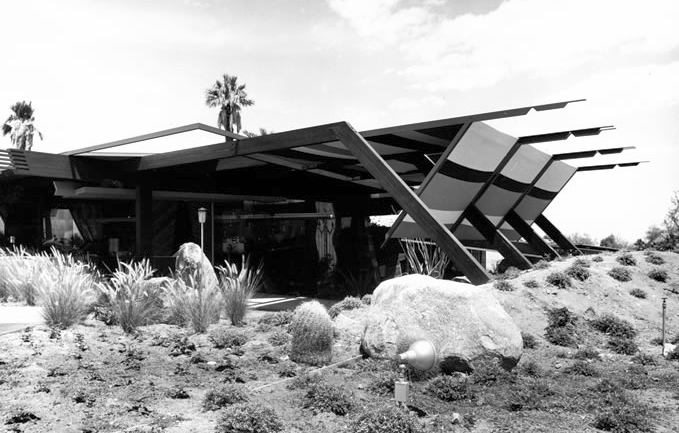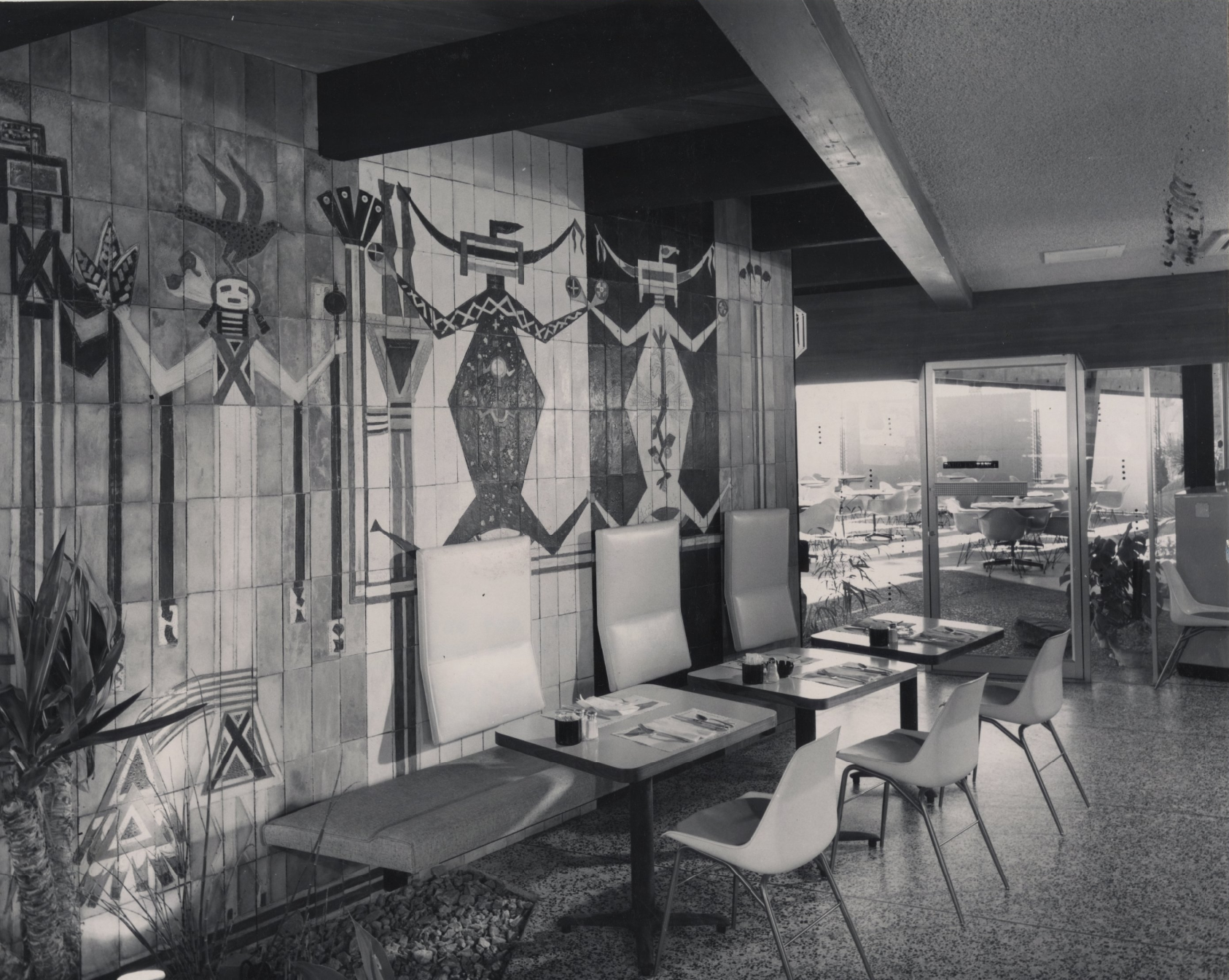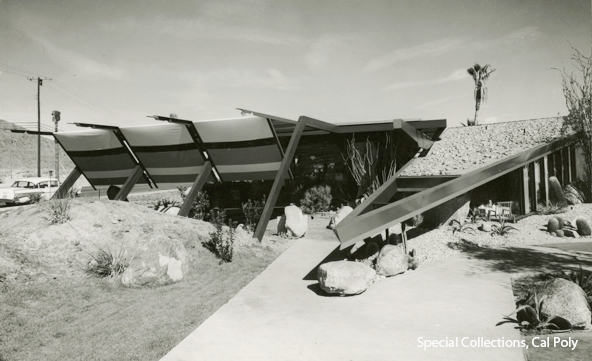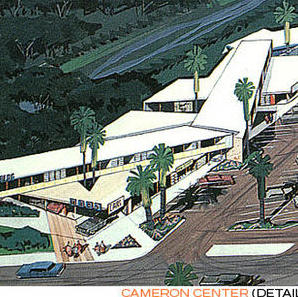1950s - Cameron Center and the Golden Mile of Tahquitz River Estates
The unfinished construction site at South Palm Canyon Drive and East Mesquite Avenue was once a source of pride for Tahquitz River Estates and the City of Palm Springs. It was here that George E. Cameron, Jr., -- a millionaire Texas oil man turned Palm Springs resident and businessman -- created one of the finest and most modern shopping centers in the country. It was called Cameron Center.
George Cameron
Cameron acquired the land in 1954 with a vision to construct a complete one-stop shopping center with parking facilities for 1,000 automobiles. Advertisements for the development claimed the Cameron Center to be “the Tomorrow of Palm Springs ... a shopping center which will attract the most distinguished stores in the world.”
Construction began in the summer of 1955 at a projected cost of $5 million. According to the Palm Springs Historical Society, the first building in the project to be completed was a Googie-style restaurant designed by local architect William Cody. The restaurant stretched north and south facing South Palm Canyon Drive. This unique building was reported to cost more than $750,000, and when it was completed near the end of 1956, a glamorous gala opening party was held to celebrate.
The development also housed many smaller local specialty shops and in the 1950s came to be known as the “Golden Mile.” In May 1960, a 30,000 square-foot Mayfair Market (the largest grocery store in Palm Springs at the time) and a 15,000-square-foot F.W. Woolworth Department Store (the first national chain to open in Palm Springs) made their debuts at the Cameron Center.
William F. Cody designed this restaurant in the Cameron Center which first "The Springs" then "Huddle Springs" restaurant, until it briefly became a Aloha Jhoes Tiki Bar and Polynesian eatery. In 1965 it was "Jeffrey's" and the last tenant was "Shermans". After a fire it was bulldozed in the 1990s and the Cameron Center was razed int he late 1990s. That is now the land of The Cameron Project.
To promote the new shopping center, a number of unique publicity events were arranged. Conveniently, Cameron owned The Desert Sun and radio station KDES, and he used both media outlets to raise awareness of Cameron Center through news coverage and promotions.
cameron center site plan
The groundbreaking ceremony on December 5, 1955 was covered as an historic event. Participating along with Cameron was world-renowned opera diva Lily Pons, who was diminutive, tastefully glamorous, and mediagenic. Miss Pons enjoyed enormous popularity not only at the Metropolitan Opera where she was leading coloratura soprano for 25 years, but also in other opera houses, concert performances and in films throughout the 1930s and 40s.
Contests were held to name the development (Cameron Center) as well as the restaurant (The Springs or Huddle Springs), and a $1,000 prize was awarded to each winner.
To celebrate the completion of the 1,000-space parking lot, “Miss Lucky Parker” was crowned. The title went to “Power Girl” Patti O’Quinn, who was associated with the famous modeling agency and charm schools founded by John Robert Powers.
Cameron also sponsored a “Lucky Parker” contest. The rules were simple. If you parked your car in the parking lot and a photographer from The Desert Sun took a photograph of your license plate that appeared in the Saturday edition of The Desert Sun, you were the winner of a free potted palm donated by Cameron.
In January 1959, Cameron announced plans to turn one corner of the property into a spacious putting green allowing for the center to be “the only shopping center in America where you can go from tea to tee.”
To commemorate the 2,000th swimming pool permit to be issued in the City of Palm Springs, the Cameron Center hosted the crowning of “Miss Cool Pool,” a title coincidentally awarded to Patti O’Quinn. At that time, Palm Springs boasted the highest per capita swimming pool and golf course ratio — one for every six residents and one for every 1,000, respectively.
The magnificent shopping area was a draw for Palm Springs residents and visitors alike. It also was a favorite and frequent stop for residents of the Tahquitz River Estates Neighborhood.
Architecturally significant neighbors and peers of Cameron Center have aged well and are still in use, including desert modernist Albert Frey’s First Church of Christ, Scientist (1956); Modernist architect Hugh Kaptur’s Impala Lodge (1957), now Triangle Inn; and the many Trousdale homes of Tahquitz River Estates.
At the time of the groundbreaking, it was reported that Cameron obtained a 99-year lease of the 12.5 acre site from George G. and Ruth B. Beebe at a cost of $1,548,000.
Cameron Center Details
- In 1954, Cameron purchased a majority interest in The Desert Sun, and within a year, he expanded it from a biweekly newspaper to a daily publication. In 1957 he purchased AM radio station KDES, and in 1963 he launched KDES FM, the first FM station in the desert.
- Adjacent to the development – at the intersection of Random Road and South Riverside Drive – is the First Church of Christ, Scientist. Designed in 1956 by the architectural firm of Clark Frey & Chambers, the property embodies the distinctive characteristics of religious architecture associated with the modern movement as interpreted by California modernist architect Albert Frey for the desert environment of the Coachella Valley.
- Another notable property built adjacent to Cameron Center was the Impala Lodge (1957-58), the first commercial property designed by Mid-Century modern architect Hugh Kaptur. Today the property is known as Triangle Inn.
- Just a block to the east of the former Cameron Center site – on both sides of the wash are the Trousdale homes of Tahquitz River Estates.
- Cameron was quick to realize that the Coachella Valley offered many possibilities. Studies he commissioned confirmed the viability of retail expansion south of the Tahquitz Creek wash.
- Cameron Center’s Bill Cody-designed restaurant building won a National Institutions award as the year’s outstanding restaurant layout in 1958.
- In 1959, Milton F. Kreis, a high-end drugstore/coffee shop proprietor, signed a 20-year lease to take over the restaurant building and it was transformed into Aloha Jhoe’s. Kreis reportedly invested $1 million in the property. The restaurant served Cantonese food, boasted an “atmospheric” tiki bar, and featured waitresses in “Suzy-Wong-type uniforms.”
- Business occupants of the once-splendid Cameron Center changed over time. During the next three decades, for instance, the restaurant was occupied by a number of eateries including Huddle Springs, Aloha Jhoe’s and Sherman’s Steak House.
LILY PONS
OPERA DIVA LILY PONS
Lily Pons was a French-American operatic soprano and actress who had an active career from the late 1920s through the early 1970s.
From 1938 to 1958, she was married to conductor Andre Kostelanetz. In 1955, they built a home in Palm Springs. It is reported that Miss Pons fell in love with Palm Springs during her first visit. She planned to stay overnight at the Ingleside Inn. Instead, she stayed 13 years.
She had had her own suite at Ingleside Inn each season for 13 years before building a home in The Mesa. On January 3, 1956, -- just one month after her appearance at the Cameron Center groundbreaking event in Palm Springs -- Miss Pons celebrated her 25th anniversary at the Met with a gala performance.
In 1968 Miss Pons co-founded the Palm Springs Opera Company, which later merged with the Palm Springs Opera Guild.







